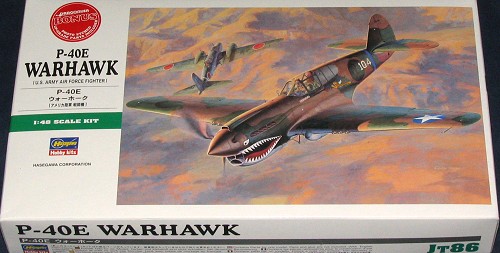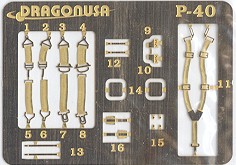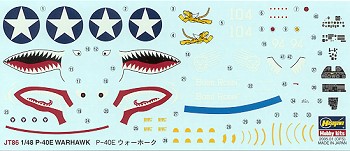
| KIT: | Hasegawa 1/48 P-40E Warhawk |
| KIT #: | 09086 (JT 86) |
| PRICE: | $29.95 MSRP |
| DECALS: | Two options |
| REVIEWER: | Scott Van Aken |
| NOTES: |

| HISTORY |
We all know that the P-40 was Curtiss' last really successful fighter. In fact, were it not for WWII, the P-40 may well have been built in relatively small numbers before the USAAC moved on to something else. However, the war did happen and Curtiss built thousands of P-40s in a rather bewindering number of variants. The more successful ones were from P-40E on. For lack of any other term, you can call these the 'big chin' versions as the oil cooler/radiator was much enlarged starting with the P-40D (of which few were built and I don't think any saw combat. The E model was the one which was really combat ready. It had self sealing fuel tanks and armor protection as well as the fire-power of six .50 caliber machine guns. It was fast in a dive and was relatively maneuverable at low level when pitted against European Axis aircraft. Against the Japanese, it was easy meat if it tried to maneuver against the much more agile Japanese aircraft.
Thanks to its rugged construction and more powerful engine, it was able to dive at high velocity, outrun the enemy and if it was hit, could take a lot of punishment before falling out of the sky. It was with the P-40 that the US went to war in the Pacific. The earlier versions were already in theater with the AVG, but those were not in US control. It was to Northern Australia that the 49th FG was deployed, later to move to southern New Guinea and to operate the P-40 through most of the war until mid 1944. The same situation befell the 23rd FG or what the AVG became in July of 1942.
Though mostly out of frontline combat with US units by early 1945, the P-40 soldiered on in the hands of Allies until war's end. Once the war was over, thousands of P-40s became little more than scrap with a few ending up in museums and the hands of war bird owners.
| THE KIT |
 Long
awaited, the Hasegawa P-40E shows that the premier Japanese aircraft model
maker is serious about doing the whole series of later P-40s. The kit has
more inserts than a Sunday newspaper and one can only hope that the fit of
all these is up to snuff. There are separate sprues for the tail, the gun
inserts, the ejector chute inserts, the windscreen, canopy and backlight.
Same goes for the exhaust and prop and instrument panel. There are options
for clear wing tip lights (you have to cut off the old ones) a gun camera,
drop tank and bomb. Two styles of wheels are provided, both spoked and
covered, though I suppose the spoked versions are for later kits. Unlike other P-40E kits, the braces for the bomb and
the drop tank are different to take into consideration the different
shapes. The cowl flaps are also molded in the open position. The prop looks
like the tips may be a bit more rounded than I'm used to seeing in P-40
kits, but may well be more accurate.
Long
awaited, the Hasegawa P-40E shows that the premier Japanese aircraft model
maker is serious about doing the whole series of later P-40s. The kit has
more inserts than a Sunday newspaper and one can only hope that the fit of
all these is up to snuff. There are separate sprues for the tail, the gun
inserts, the ejector chute inserts, the windscreen, canopy and backlight.
Same goes for the exhaust and prop and instrument panel. There are options
for clear wing tip lights (you have to cut off the old ones) a gun camera,
drop tank and bomb. Two styles of wheels are provided, both spoked and
covered, though I suppose the spoked versions are for later kits. Unlike other P-40E kits, the braces for the bomb and
the drop tank are different to take into consideration the different
shapes. The cowl flaps are also molded in the open position. The prop looks
like the tips may be a bit more rounded than I'm used to seeing in P-40
kits, but may well be more accurate.
In terms of glitches, there were not many. There are tiny ejector pin marks in the separate wheel wells and my seat frame had been broken in half by all the sprues banging around in the bag. I also found some sink areas under the wing and the ejector pin holes are so deep on the inside of the wing that there are impressions of them on the outside. They will probably disappear under paint. I do like having the gun barrels already drilled out and wish they could have done the same with the exhaust stubs. I also found ejector pin marks on the wheels and the landing gear.
What isn't offered are separate flaps, and this is just fine as the vast majority of P-40 photos you see have these raised when parked. Other inserts are for the cooling vents (or lack of in the forward nose, the carb intake, and you'll have to plug a few holes, drill a few holes, and trim a part or two during the construction.
 The interior is pretty
nicely detailed, though not really to the same standard as their Japanese
fighters such as the Ki-84 and Ki-43. However, it is more than adequate for
most of us. The initial US boxing includes an etched fret that is basically
seat harness and a small box to attach to the seat. No big whoop, but
better than nothing. From what I can see, the seat and instrument panel are
appropriate for this aircraft. The P-40 is not that complex an aircraft,
even with all the inserts so it should build well.
The interior is pretty
nicely detailed, though not really to the same standard as their Japanese
fighters such as the Ki-84 and Ki-43. However, it is more than adequate for
most of us. The initial US boxing includes an etched fret that is basically
seat harness and a small box to attach to the seat. No big whoop, but
better than nothing. From what I can see, the seat and instrument panel are
appropriate for this aircraft. The P-40 is not that complex an aircraft,
even with all the inserts so it should build well.
 We have the usual fine
instructions that include color info in Gunze paints. There are also a few
detail drawings to make sure we don't hose something up in the process of
building it. Markings are for two planes. One is a 23rd FG Flying Tiger
P-40 just after its inception as flown by Ed Rector. It is in the RAF
equivalent colors. The other is from the 49th FG in Australia during the
summer of 1942 and is basically in OD over Neutral Grey. There are areas of
black that will have to be painted on the nose prior to applying decals.
The decals themselves appear to be the more improved variety with actual
white white instead of the usual ivory. I'd be willing to bet that they are
slightly transparent as they look a bit faded on the light blue background.
However, they are well printed an offer two styles of instrument panel
decals, one with and one without the black background. I really like these
as they tend to fit exactly over the instruments, saving me from having to
paint the individual dials!
We have the usual fine
instructions that include color info in Gunze paints. There are also a few
detail drawings to make sure we don't hose something up in the process of
building it. Markings are for two planes. One is a 23rd FG Flying Tiger
P-40 just after its inception as flown by Ed Rector. It is in the RAF
equivalent colors. The other is from the 49th FG in Australia during the
summer of 1942 and is basically in OD over Neutral Grey. There are areas of
black that will have to be painted on the nose prior to applying decals.
The decals themselves appear to be the more improved variety with actual
white white instead of the usual ivory. I'd be willing to bet that they are
slightly transparent as they look a bit faded on the light blue background.
However, they are well printed an offer two styles of instrument panel
decals, one with and one without the black background. I really like these
as they tend to fit exactly over the instruments, saving me from having to
paint the individual dials!
| CONCLUSIONS |
Well, we have all wanted a modern, Tamigawa P-40 and now we have it. Doesn't mean that you have to relegate your others to the scrap pile as they still make nice models, but now, we have the latest and greatest with more to come.
| REFERENCES |
Kit courtesy of me and I actually paid retail for it!!!! (sound of screeching violins).
If you would like your product reviewed fairly and quickly by a site that has 300,000 visitors a month, please contact me or see other details in the Note to Contributors.